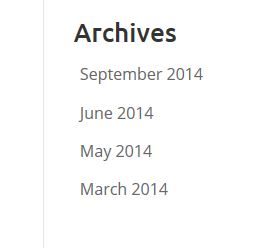This year’s Shop Small events had a focus on Digital Marketing, so I went along to the Sydney one to check it out. I’m going to write another post with a general report, but today I want to talk about running a successful small business blog. I’ll look at quantity of posts, quality of posts, and finding time to post, then finish off with a client example.
Why your small business should have a blog
Before diving into detail, let’s look at why you should have a blog. These reasons are in no particular order:

- It helps you get traffic (read on to the end of the post for a client example.)
- By their very nature, blogs mean your site gets refreshed with new content. And Google loves new content, so that’s a massive advantage if you want to be found in search engines.
- New content also gives visitors to your site a reason to come back.
- Blog posts are great starting material for all your other content marketing activities:
- use them as newsletter articles
- update Facebook, LinkedIn, Twitter and other social media sites with links back to your post as a way to get more traffic
- if you allow comments, it means your web visitors can give you feedback
- You can share news about your business, your industry or your community
- Your blog can ‘put a face to the name’. So your business has more personality, more story, becomes more interesting. (Remember, people do business with people, not companies!)
So why doesn’t every small business blog?
There are two main objections:
- I don’t know what to blog about
- I don’t have time
The detail of what to blog about is different for each organisation. Brainstorming (with your team, with clients in the pub, with your friends, at a conference) is a useful start. This list of types of blog post may give your more ideas. I’m also a great fan of editorial calendars. Even if you don’t stick to them, they give you a starting point, which is easier than a blank screen.
Finding time to blog, on the other hand, is a universal challenge – and the issue at the heart of this post.
How much time does a blog post take?
What the digital experts said
Two speakers at Shop Small made statements about time spent on web content.
- Yvonne Adele talked about digital marketing in ‘ten minutes a day, three times a week’. According to her slide, that half hour includes two blog posts, as well as social media. All in half an hour a week.
- Ben Mangold talked about updating his Google+ page (ok, not strictly speaking a blog, but the Google+ equivalent) 4 times a week, taking 20 minutes each time. That’s eighty minutes – for the sake of argument let’s round it up to ninety minutes, or an hour and a half.
Two to four blog posts in less than two hours a week?
To be fair, Yvonne talked about ‘quick content’ forms, like uploading a photo of a celebration cake or your latest swimwear design, or yourself at the Shop Small event. You can probably do that in 10 minutes. All you need to do is upload the photo and publish. But if you want to do it really well and get the maximum benefit (ie not just another blog post, but one which helps you get more website visitors and convert them to leads), you need to do a bit more.
- optimise photo size and resolution so it loads quickly. (How fast your pages load is a factor Google uses to rank your site.)
- make sure the photo file name and alt tag reflect a good keyword. This helps you show up higher in search results. So first of all you have to work out what a good keyword is.
- Consider including a caption.
- Work out what you want visitors to do next after they view this photo on your site. Create a call to action, or a link, so that they don’t just bounce straight back out to the wilds of hyperspace and get lost forever.
So even for a photo, ten minutes is starting to sound a bit tight.
By the way, these same experts say your blog content has to be relevant, engaging and useful. I agree with them. But while a quick photo post may work if you’re selling cakes, or haircuts, or fashion, for many businesses it doesn’t. If you’re selling marketing services (like me!), or software, or accounting, or even psychic consultations, your potential customers may need something a bit meatier to pull them in.
Your blog posts might need to be:
- A client or project story.
- An interview with a member of your team.
- A report on an industry event.
- Some tips how your customers (and target customers) could do business better.
I just don’t believe you can post this kind of content, consistently, in ten or fifteen minutes.
How often should you update your small business blog?
What the experts say
Yvonne said twice a week if possible. Maybe once a week.
Ben said he updated Google+ four times a week.
What the experts do
Yvonne’s blog (as of 21 November) has
- 5 posts published in September
- 0 posts published in October
- 0 posts published in November

Her archives widget tells the same story. It looks like she does a flurry of posts when she’s got time, then gets busy and slips for a while, then starts posting again.
To be fair, I know how she feels. It happens to me too. You can see it on the NoBull Marketing Blog. (Cobblers’ wives go barefoot, doctors’ wives die young, digital marketing experts don’t blog consistently…)
But I won’t do it on client blogs!
Ben’s got a different challenge. He’s got a personal blog/website, a Google+ page, and a company blog he contributes to. From a quick review, most of his effort is going into Google+ and he is posting every day or two. So he’s consistent with what he said. Full marks for that. (My own preference would be to build company profile over personal profile – but that’s a matter of personal choice.)
What I say
Your content MUST be relevant, engaging and useful. That’s quality. Quality takes time. Especially when you’re starting out, you don’t have much experience and you don’t know what works.
A smaller, consistent volume of quality content will deliver you better results in the long term.
Set your quantity target low and your quality target high, then set up systems to deliver on those target.
- For a small business blog, a good rule of thumb is to publish a quality article every two weeks. By a happy coincidence, this also gives you just enough content for a monthly newsletter. And since some months have five weeks, you can slip occasionally.
- Create an editorial calendar, then schedule blogging time in your work diary. Make an appointment with yourself. Allow a minimum of two hours, maybe three or four.
- If something newsworthy or interesting comes up, try to do an immediate quick blog post on that. This could take ten minutes to an hour, depending on what it is. Congratulations! You are now one post ahead on your target.
- For every post, make sure you have at least one image.
- Try to have a ‘focus keyword’ for every post. This has the following benefits:
- It means you know what you are writing about and stops you rambling.
- Use the keyword in the blog title, a heading and the text. Create an SEO title and a meta-description using it as well, and your post will show up higher in search results for that term.
- Always remember, you are writing for the reader, not for Google. Don’t push the keyword into the text if it makes it sound awkward.
What I do
As I mentioned, for NoBull’s blog, I’m pretty much like Adele. A flurry of activity and then nothing. Clients come first.
For clients, see the ‘What I say’ section. And take a look at the client example below!
A Real Life Small Business Blog
NoBull Marketing have been looking after the Xpadite blog since September 2013. Here’s what we’ve done:
- There are 32 published posts (excluding the first two which the web developers had put on before we took over). 32 in 15 months is just over two a month.
- The posts are generally around 7-800 words long. This gives time to present and develop an idea. To give some useful content as opposed to a soundbite.
- All the posts have at least one image. Some have many, especially when the topic is about printed materials.
- There are case studies and client examples. (I’d like more of these, but some Xpadite clients are shy, so we have to respect their wishes.)
- There are a couple of video posts too, which add variety and interest.
And the results?
This chart shows how organic search traffic to the website has grown. Nearly half (48%) of all website traffic is from organic search.

So how do I know the blog drove that traffic? I looked at the detail of which pages that traffic came to – in other words, which web pages were showing up in search results. From July to September 2014, 70% of our organic search traffic came to blog posts.
So a third of Xpadite’s website traffic now comes from their blog. (70% of 48% is 33.6%.) Not a bad result!
Notice, though, that it took time. A year or so of posting before the growth really began. Why? Well, once you have those 20-odd posts, you have a collection of webpages addressing different but related ideas. It’s additional evidence to Google that your site has depth and quality. A single post struggles. Once it gets team-mates, it has more chance of performing.
***
Do you want to start or improve your small business blog?
If anything in this post gives you ideas or helps you with your blog, I’d love feedback. And if you disagree with my points, let me know why. (Hopefully at least one of us will learn something in the debate!)
If you’re nervous about going it alone with your blog, NoBull Marketing can assist with:
- the mechanics of setting up a blog
- learning about on-page SEO (search engine optimisation)
- developing a blog content plan
- writing and posting blog content on your behalf
Why not contact us for a no-obligation chat?
(By the way this post took about 3-4 hours, including research, loading images and search engine optimisation.)







